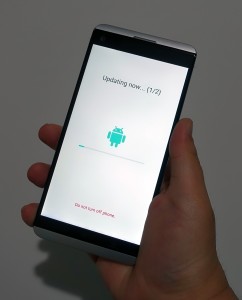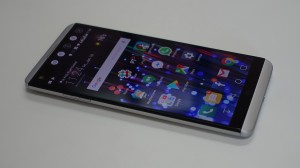 LG V20 is a high-end smartphone from LG powered by Qualcomm Snapdragon 820 processor and Android Nougat. It features Hi-Fi Quad DAC audio, wide angle camera with manual mode capable to shoot RAW, HD audio recording, dual SIM card, removable battery, 5.7″ screen with 331 ppi pixel density and always-on secondary display. It has fingerprint reader at the back side, which also doubles as the power button.
LG V20 is a high-end smartphone from LG powered by Qualcomm Snapdragon 820 processor and Android Nougat. It features Hi-Fi Quad DAC audio, wide angle camera with manual mode capable to shoot RAW, HD audio recording, dual SIM card, removable battery, 5.7″ screen with 331 ppi pixel density and always-on secondary display. It has fingerprint reader at the back side, which also doubles as the power button.
First, why would I need yet another Android phone? Well, my Nexus 5 is aging and it started to feel a bit sluggish from time to time. Furthermore, due to some circumstances, I currently need to maintain 2 extra SIM cards on top of my main number. I don’t like the idea of carrying 3 phones everywhere, so I started researching for a good phone with dual SIM card. Clearly, I wouldn’t hope such feature from any Apple phone. Therefore Android is the logical choice. This particular V20 model got into my candidate list when I saw a demo unit in a store. Went there to check out LG G6, ended up liking V20 for the always-on secondary display. I think it looks cool and I could immediately see various real-use situations when it would come in handy. Didn’t buy the phone immediately. Went back home to research more, find out the cheapest possible price, then ordered it online few days later.
LG V20 comes in a box with rather modest design. The phone itself looks solid and well built. At the front, there’s a 5MP f/1.9 camera. It is positioned on the upper-left instead of middle because the upper-right side has the always-on secondary display. The always-on display is 2.1″ with 160 x 1040 pixels. When the phone is locked, we can choose to display date & time or quick tools (sound profile, Wi-Fi, flashlight, Bluetooth and screen capture). By default, this secondary display will never goes off (as long as the phone has power, of course), but we can also set it to go off during certain period of time (night time when we sleep, for example). When the main screen is on, we can choose to show any word or phrase on the secondary screen (the default setting is to show our name), quick tools, app shortcuts, music player, quick contacts, recent apps or upcoming plans (events and tasks). Each choice can be turned on or off and swiping left or right on the secondary screen will change what’s being displayed. There is no button on the front side. The home button is displayed on-screen when the phone is not locked, and some other buttons are customisable. It’s worth to note that this phone comes with default screen protector pre-attached. Very handy so I won’t need to immediately find a good screen protector.
 On the left side, there are 2 buttons: volume up and down. On the top, there is infra-red beamer and a tiny microphone hole. Speaker, microphone hole, USB-C port (for charging and data transfer) and 3.5mm audio jack slot are placed at the bottom. A button to open the battery cover is located on the right side. At the back, we can see the dual camera of 16 MP (29mm, f/1.8) + 8 MP (12mm, f/2.4) with laser autofocus, optical image stabilisation and LED flash. The power button is placed under the back camera. The same button is also a fingerprint reader. Open the battery cover and we will find the removable Li-Ion 3200 mAh battery, 2 nano SIM card slots and 1 micro-SD card reader for storage expansion. It think it’s super nice to find a modern flagship smartphone with removable battery. Another note is that if we do choose to expand the 64 GB internal storage with micro-SD card, one of the SIM card slots will not be usable.
On the left side, there are 2 buttons: volume up and down. On the top, there is infra-red beamer and a tiny microphone hole. Speaker, microphone hole, USB-C port (for charging and data transfer) and 3.5mm audio jack slot are placed at the bottom. A button to open the battery cover is located on the right side. At the back, we can see the dual camera of 16 MP (29mm, f/1.8) + 8 MP (12mm, f/2.4) with laser autofocus, optical image stabilisation and LED flash. The power button is placed under the back camera. The same button is also a fingerprint reader. Open the battery cover and we will find the removable Li-Ion 3200 mAh battery, 2 nano SIM card slots and 1 micro-SD card reader for storage expansion. It think it’s super nice to find a modern flagship smartphone with removable battery. Another note is that if we do choose to expand the 64 GB internal storage with micro-SD card, one of the SIM card slots will not be usable.
Android Nougat in LG V20 runs smooth. LG does implement some extra UX touches here and there, but nothing seems to be significantly slowing down everyday performance. One thing I love the most about LG’s version of Android: it allows us to remove Android’s app drawer. Yes, app drawer, my most ultimate annoyance in using Android. I can’t say enough how much I hate having 2 layers of “menu” to start my apps. Basically LG offers “Home” (no app drawer), “Easy Home” (no app drawer, simpler layout and larger font size, perfect for senior users) and “Home & App Drawer” interface. This one of my strongest reason of going LG this time.
Just like any other non-vanilla Android phones, updates are slow. Until today, my LG V20 still stuck with Nougat 7.0. So looking forward to the day it will receive 7.1.2, if ever.
 Battery life is good. Since this is not my primary phone, I don’t use it often, most of the time on standby and occasionally receiving messages. Under this usage pattern, one full charge could easily survives 3 days. Removable battery means I could actually opt to get another battery and swap it on the go, if really needed. I end up not getting my second battery just yet, maybe later in the future when I see the need. Charging with USB-C is a new challenge because I don’t have a lot of spare charging cables. I only have one cable included with this phone, plus my Macbook 2012 charging cable. Since USB-C is the future, I figured it might worth the investment to get some good USB-C cables. V20 supports fast battery charging Quick Charge 3.0. Initially I didn’t think this matter at all. But one time I forgot to charge this phone and it got completely depleted. When I charged it, took a while just to get it running, then when the battery is still under 5%, it kept showing annoying message about low battery, even it was in plugged-and-charged condition. I basically couldn’t do anything with my phone in such condition. Waited half an hour until it got reasonable amount of power before I could do anything. Not sure if getting QC 3.0 compatible charger will make significant improvement, but I guess I’ll get some anyway.
Battery life is good. Since this is not my primary phone, I don’t use it often, most of the time on standby and occasionally receiving messages. Under this usage pattern, one full charge could easily survives 3 days. Removable battery means I could actually opt to get another battery and swap it on the go, if really needed. I end up not getting my second battery just yet, maybe later in the future when I see the need. Charging with USB-C is a new challenge because I don’t have a lot of spare charging cables. I only have one cable included with this phone, plus my Macbook 2012 charging cable. Since USB-C is the future, I figured it might worth the investment to get some good USB-C cables. V20 supports fast battery charging Quick Charge 3.0. Initially I didn’t think this matter at all. But one time I forgot to charge this phone and it got completely depleted. When I charged it, took a while just to get it running, then when the battery is still under 5%, it kept showing annoying message about low battery, even it was in plugged-and-charged condition. I basically couldn’t do anything with my phone in such condition. Waited half an hour until it got reasonable amount of power before I could do anything. Not sure if getting QC 3.0 compatible charger will make significant improvement, but I guess I’ll get some anyway.
Audio quality is one aspect worth special place in this review. I was sceptical about this feature, thinking it’s just gimmicky thing. After all, this phone already gave me so many other reasons to choose it. When I actually test it, I was really impressed with the Hi-Fi Quad DAC audio.
To be fair, when I tried music listening using some cheap earphones, the sound quality made almost no difference. When I tested using my Bose SoundTrue Ultra in-ear, Sennheiser Momentum and Sony MDR-1RBT in wired mode, I was blown away. turning on the Hi-Fi Quad DAC menu does make a difference. Without this feature turned on, my music sounded more or less like how I usually hear it from my iPhone. Turning this on gets me richer sound, better bass and enjoyable details. It’s awesome!
For security, LG V20 allows us to protect our phone with PIN, pattern, knock code, password, fingerprints or the unsecured swipe to unlock. It also allows us some fancy smart lock options from on-body detection (keep my phone unlocked when it’s near human body, not sure why anyone would choose this), trusted place (keep the phone unlocked when in trusted location), trusted devices (keep the phone unlocked when near a trusted device), trusted fact (device will unlock if face is recognised, I tried, it sucks) or trusted voice (unlock device with trusted voice). The KnockON feature allow us to turn on screen by double-tapping. This is another super useful feature so I don’t need to flip my phone every time I need to use it. Whoever came up with the idea of moving power button to the back should go back to school and re-learn about UX. It’s crap.
Smart Settings feature allow us to automatically select sound profile, Bluetooth or Wi-Fi auto change when we’re at home or away from home. Sounds handy and I would probably use it if this is my primary phone. We can also select app to auto open when earphones are plugged in or when Bluetooth device is connected.
The back camera is not bad. Clearly nowhere near the level of my trusty Sony RX100 III, but it’s quite decent. In most cases, it captures better photos than my iPhone 7’s back camera. Side by side comparison shows V20’s photos look somewhat brighter and more colourful. The colourful part can be a double-edged blade sometimes when V20’s colour is looking less natural, or more vivid than the actual object. iPhone 7 does better work with objects that shines light. For audio recording, V20 is the clear winner.
I end up liking V20 more than what I initially thought. I still much preferred to use iOS as my primary phone, but for an Android phone, LG V20 is a really really good phone.

Leave A Comment